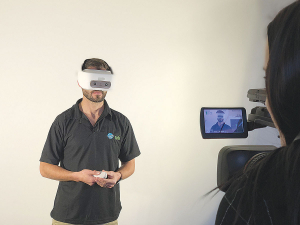Biosecurity progress and challenges for NZ winegrowers
Dr Ed Massey is General Manager Sustainability at New Zealand Winegrowers.
 ECO FRIENDLY: Reuben Turner inspects biosecurity training provider IVS’s new virtual shipping container.
ECO FRIENDLY: Reuben Turner inspects biosecurity training provider IVS’s new virtual shipping container.
Cutting edge technology designed to simulate biosecurity threats has emerged from the collaboration of two Hamilton companies.
A pioneering virtual reality shipping container packed with simulated biosecurity risk scenarios is helping preserve New Zealand’s ecosystem and way of living.
Independent Verification Services (IVS) in Hamilton has launched a new virtual reality (VR) simulation built by Hamilton software specialist Company-X. The Ministry of Primary Industries has approved the technology to be used in biosecurity refresher training.
The project was led by Company-X augmented and virtual reality specialist Lance Bauerfeind, with project manager Dilan Prasad and augmented and virtual reality generalist Wonkee Kim.
Using virtual reality to assess frontline staff dealing with imported goods was a New Zealand first, said IVS chief executive Peter Webb.
“It’s the first training course that is not undertaken in a classroom, using a written examination-style assessment. Instead, it offers an online course with a virtual reality assessment that lets trainees demonstrate their practical knowledge and skills.”
The technology provides trainees with a realistic environment to properly assess their abilities to detect and respond to biosecurity threats such as foreign insects and vegetation.
A wireless virtual reality headset allows the person to walk around the simulated container externally and internally, in the same way that they would in the real world.
“The virtual reality tool is the closest and more realistic assessment of skills,” Webb said. “It replicates real-life situations that may be encountered on the job.
“We randomise all the different things that can happen, like poisonous spiders,” Bauerfeind said.
“We can trick head movements so we know where they are looking.”
“We chose to work with the team at Company-X due to their experience and capability. The fact that they are based here in the Waikato, was also a bonus,” Webb said.
The project, Webb said, was the first step in what could be a transformational journey for the biosecurity industry in New Zealand. It uses virtual reality to train staff dealing with biosecurity contamination immediately post-border in the most realistic way.
“This technology has the potential to be used to educate all New Zealanders to identify and respond to biosecurity risks,” he said.
“IVS believes virtual reality could be instrumental to achieving a biosecurity team of 4.7 million, where all New Zealanders are aware of the importance of biosecurity and involved in pest and disease management, as set out in the Government’s Biosecurity 2025 strategy.
Horticulture New Zealand (HortNZ) says a new report projects strong export growth for New Zealand's horticulture sector highlights the industry's increasing contribution to the national economy.
Fonterra shareholders say they will be keeping an eye on their co-operative's performance after the sale of its consumer businesses.
T&G Global says its 2025 New Zealand apple season has delivered higher returns for growers, reflecting strong global consumer demand and pricing across its Envy and Jazz apple brands.
New Zealand's primary sector is set to reach a record $62 billion in food and fibre exports next year.
A new levying body, currently with the working title of NZWool, has been proposed to secure the future of New Zealand's strong wool sector.
The most talked about, economically transformational pieces of legislation in a generation have finally begun their journey into the statute books.
President Donald Trump’s decision to impose tariffs on imports into the US is doing good things for global trade, according…
Seen a giant cheese roll rolling along Southland’s roads?